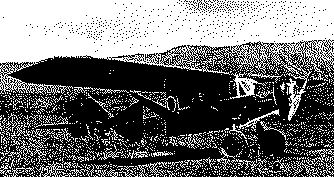PIONEER AIR MUSEUM
The Pioneer Air Museum, housed in a large gold-domed building
at Alaskaland, chronicles the development of flight in Alaska.
Farthest North Air Museum in the U.S.A., the Gold Dome is
filled with authentic antique aircrafts and memorabilia of
Alaska's aviation heritage.
The stories chronicled here in the interpretive displays focus on solo piloting
adventures, as well as the early commercial cargo aircraft that operated in the bush.

Photo from Lulu
Fairbanks Collection, courtesy of UAF Archives.
Included in the museum are over 500 photographs of aviation activities
(beginning with the first aircraft in the Territory), including the Alaska/Siberia lend
lease discussed on our Fort Wainwright and
Eielson AFB pages. There are also fourteen aircrafts and
over 20 aircraft engines, including the largest piston engines produced.
Remnants of the wreckage of Carl Ben
Eielson's plane, recovered in 1991, are among the most popular exhibits. The
plane crashed in 1929 off the coast of Siberia. On Feb. 4, 1948, the Air Force changed the name of
26-Mile Post to Eielson Air Force Base in honor of the Arctic aviation
pioneer, a famous "bush pilot" in the Interior during the 1920s.
It was
he, along with Australian explorer Sir Hubert Wilkins, who, in 1928, made the first flight
over the polar ice cap from the North Slope to Spitzbergen, Greenland, a 2,200-mile route.
The flight earned Eielson the Distinguished Flying Cross and the 1928 Harmon Trophy for
the greatest American aviation feat of the year.
Sadly, he did not have very long to savor his award. Eielson and his mechanic,
Earl Boland, were killed only one year later, during a flight in a blizzard in 1929. They
were trying to rescue stranded passengers and $1 million in furs aboard a freighter caught
in the ice off the Siberian coast. Their bodies and the wreckage of their plane were found
79 days later on a small island off the coast of Siberia.
The Interior and Arctic Alaska Aeronautical Foundation started from a dream in
1977 to preserve the early history of Ladd Field,
an Army Air Corps base near Fairbanks. They succeeded in having the original quadrangle
designated as a historical site in 1987. They fully organized in 1982 and began collection
material for a museum.
It was in 1984 that the City of Fairbanks offered the I.A.A.A.F. an unoccupied
building located in the Alaskaland Centennial site. The building is a large tetrahedron
structure with a diameter of 134 feet and 38 feet tall. It is known as the Gold Dome.
There was a lot of pressure to have the Museum open by 1992 for the 50th
Anniversaries of the Alaska Highway, the Alcan Pipeline, the Alsib Lend Lease program,
among other celebrations. At that time, only 10 aircraft and thirteen engines were on
display, along with about 300 pictures and other small artifacts. Admission was free, with
donations being solicited. There were 84,000 viewers (counting children) that year, even
though the Museum was open only 101 days of 10 hours each.
For the 1993 season, a display case of early aircraft radios was added, along
with more of everything and three other large display cases. An admission fee of $1 and
the requirement for adults chaperones for children under 12 lowered the season attendance
to 16,000.
In 1994, a heating system was added to the Gold Dome, making it more
comfortable for visitors on cool, overcast days. Many building code deficiencies were
corrected at that time, and a sprinkler system installed to bring it up to Alaska state
fire code.
The Pioneer
Air Museum is open from Memorial Day through Labor Day, from 11 a.m. to 9
p.m. and costs only $2 for adults, $5 for families. All proceeds go to support and
preserve the Museum.
